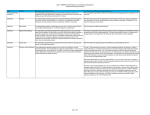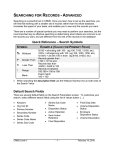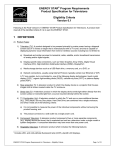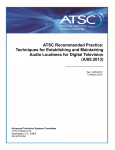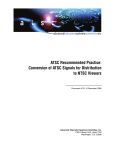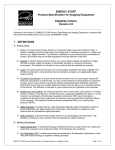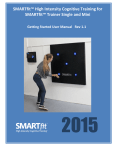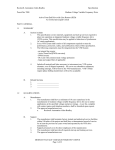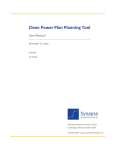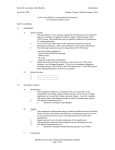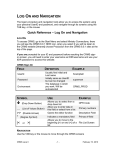Download Draft 1 Version 7.0 ENERGY STAR Televisions Specification
Transcript
ENERGY STAR® Program Requirements Product Specification for Televisions Eligibility Criteria Draft 1 Version 7.0 1 2 3 Following is the Draft 1 Version 7.0 ENERGY STAR Product Specification for Televisions. A product shall meet all of the identified criteria if it is to earn the ENERGY STAR. 4 5 6 7 Note: On October 25, 2013, the U.S. Department of Energy (DOE) issued a Final Rule establishing a new test procedure for television sets. The U.S. Environmental Protection Agency (EPA) has incorporated by reference this test procedure, Appendix H to Subpart B of 10 CFR § 430, into this Draft 1 Version 7.0 specification. The test procedure is herein referred to as Appendix H. 8 For more information and to view Appendix H, please visit the following website: 9 http://www.regulations.gov/#!documentDetail;D=EERE-2010-BT-TP-0026-0076 10 1 DEFINITIONS 11 12 Note: EPA removed the following definitions as they no longer serve a purpose in differentiating Televisions (TVs) in today’s market: 13 - Rear-projection TV - No longer manufactured. 14 - Direct-view TV - All new TVs on the market are direct-view. 15 - Component Television – No longer available on the consumer market. 16 - Analog & Digital Television - All new TVs on the market are digital. 17 18 - TV Combination Unit - This type of product is a Television offering Additional Functions as defined below and does not require a separate product classification. 19 A) Product Types: 1 20 21 22 1) Television (TV) : A product designed to produce dynamic video, contains an internal TV tuner encased within the product housing, and that is capable of receiving dynamic visual information from wired or wireless sources including but not limited to: 23 24 a) Broadcast and similar services for terrestrial, cable, satellite, and/or broadband transmission of analog and/or digital signals; 25 26 b) Display-specific data connections, such as HDMI, Component video, S-video, Composite video; 27 c) Media storage devices such as a USB flash drive, a memory card, or a DVD; or 1 10 CFR 430, Subpart A ENERGY STAR Program Requirements for Televisions – Draft Eligibility Criteria Page 1 of 19 28 29 30 d) Network connections, usually using Internet Protocol, typically carried over Ethernet or Wi-Fi. Note: EPA harmonized the definition of Television (TV) with Appendix H. 2) Hospitality Television: A TV product which includes the following features: 31 32 a) A control port for bi-directional communication (DB-9, RJ11, RJ12, RJ45, coaxial cable, or HDMI-CEC); and 33 34 35 36 b) Activated hospitality protocol software (e.g., SmartPort, Meeting Professionals International (MPI), Multiple Television Interface (MTI), Serial Protocol) to provide direct access to VideoOn-Demand (VOD) systems or a digital media player designed for hospitality-specific applications. 37 38 39 40 Note: EPA seeks comment as to whether this definition needs to be updated so as to be relevant to Hospitality TV functions available today. EPA seeks feedback on how Hospitality TVs, particularly those that are designed and marketed to operate on IP networks, differ from consumer TV network functions. EPA seeks to ensure that the Version 7.0 requirements appropriately address any functional differences. 41 B) Operational Modes: 2: 42 43 1) On Mode The power mode in which the product is connected to a mains power source, has been activated, and is providing one or more of its principal functions. 44 45 Note: EPA proposes to remove the following “Power Overhang State” definition that is included in the current specification (shown in italics): 46 47 48 49 Power Overhang State: A limited-duration power state within On Mode that is intended to facilitate a product’s rapid return to full On Mode functionality or provide time for the product to perform functions required for safe shutdown (e.g., operation of cooling fans) after being switched into a low power state by the user. 50 51 52 53 54 55 56 57 58 59 60 61 62 63 64 65 66 This state was originally proposed in 2010 to prevent a TV from spending long durations in a high power standby state following a user prompt to put the TV into standby from On Mode. Appendix H does not specify procedures for testing this state. Further, there is a limited number of Version 6.1 certified TVs (approximately 25 models) with tested and reported values for this state which is utilized for quick-start states and multi-controller unit operation. Spending a few minutes to safely shutdown applications and components results in negligible energy use. EPA is nevertheless concerned about states that facilitate a rapid return to full On Mode functionality which result in power levels over 20 W and may last up to a couple of hours following the prompt to go to standby or more depending on the TV settings. The implementation of quick-start states where power to processors is maintained rather than employing improved memory to store the active configuration of the picture and tuner processors may result in significant increases to overall annual energy use. EPA seeks to ensure it recognizes models with energy-efficient quick-start implementation and considers that this feature is better classified as a special function under Standby modes as described in Appendix H. As such, EPA proposes removing the “Power Overhang State” (subset of On Mode) and, instead, intends to review power used to facilitate quick start in Standby. EPA welcomes stakeholder feedback on this proposal. EPA also requests stakeholder feedback on the duration, power use, and function of any states that a TV may enter following a user prompt to leave On Mode. 2 10 CFR 430, Subpart B, Appendix H, Section 2.14 ENERGY STAR Program Requirements for Televisions – Draft Eligibility Criteria Page 2 of 19 3 67 68 69 2) Standby-Passive Mode : The mode in which the TV is connected to a power source, produces neither sound nor picture, but can be switched into another mode with the remote control unit or an internal signal. 70 71 72 73 3) Standby-Active, Low Mode : The mode in which the TV is connected to a power source, produces neither sound nor picture, but can be switched into another mode with the remote control unit or an internal signal, and with an external signal, and is not exchanging/receiving data with/from an external source. 74 75 76 77 4) Standby-Active, High Mode : The mode in which the TV is connected to a power source, produces neither sound nor picture, but can be switched into another mode with the remote control unit or an internal signal, and with an external signal, and is exchanging/receiving data with/from an external source. 78 79 80 81 82 83 84 85 86 87 88 89 90 91 92 93 94 95 4 5 a) Download Acquisition Mode: The power mode in which the product is connected to a mains power source, produces neither sound nor picture, and is actively downloading data. Data downloads may include channel listing information for use by an Electronic Program Guide, TV setup data, channel map updates, firmware updates, monitoring for emergency messaging/communications or other network communications. Note: EPA first introduced the definition of Download Acquisition Mode (DAM) under Version 3.0 in 2007 and subsequently included DAM requirements for Hospitality TVs in Versions 5.3 and 6.1. Now that network communications have evolved significantly in both consumer and Hospitality TVs, EPA is reviewing the DAM definition and test procedures. EPA has identified many TVs meeting the definition for Hospitality TV that were not tested in DAM for certification to Version 6.0 and 6.1 despite the Section 3.7 DAM Requirements and Section 3.8 Hospitality TV Requirements. Should any distinctions relevant to the energy consumption exist between TVs intended to operate in hospitality environments and those sold at retail, EPA is considering making requirements more clear in Version 7.0 such that all TVs intended to operate in hospitality environments are consistently tested and assessed in DAM. Therefore, EPA is requesting stakeholder feedback on the applicability and relevancy of DAM. 6: 5) Off Mode The mode where the TV is connected to a power source, produces neither sound nor picture, and cannot be switched into any other mode with the remote control unit, an internal signal, or an external signal. 7 96 97 98 C) Additional Functions : Functions that are not required for the basic operation of the device. Additional functions include, but are not limited to, a VCR unit, a DVD unit, an HDD unit, a FM-radio unit, a memory card-reader unit, or an ambient lighting unit. 99 100 101 102 1) Thin Client Capability: The ability of the TV to receive, decrypt, and display encrypted content provided by a Multichannel Video Programming Distributor (MVPD) over the Local Area Network via a server device co-located on the customer premises without the need for a client device at the TV. 3 10 CFR 430, Subpart B, Appendix H, Section 2.18 4 10 CFR 430, Subpart B, Appendix H, Section 2.20 5 10 CFR 430, Subpart B, Appendix H, Section 2.19 6 10 CFR 430, Subpart B, Appendix H, Section 2.13 7 10 CFR 430, Subpart B, Appendix H, Section 2.1 ENERGY STAR Program Requirements for Televisions – Draft Eligibility Criteria Page 3 of 19 103 104 105 106 107 108 109 110 111 112 113 114 115 116 117 118 119 120 121 122 123 124 125 126 Note: EPA proposes definitions to capture the capabilities of TVs that are able to replace set-top boxes and are provided to a household by a Multichannel Video Programming Distributor (MVPD). As TVs with “smart” functionality become more common, EPA sees the potential for eliminating redundant electronics in the home to save both material resources and energy. The proposed definition of Thin Client Capability is intended to capture those TVs that are capable of receiving content from a media server in the home over a Local Area Network connection (e.g., Coax cable, Ethernet, Wi-Fi). The media server could be a gateway with modem and router functionality or a fully-featured set-top box that delivers content to a TV. Standards such as DLNA, MoCA 2.0, and RVU may be employed for interoperability between the TV and the server device. EPA welcomes feedback on these TV technologies and other features that allow the set-top box to be replaced for satellite, cable, and IP content delivery from MVPDs and is interested in better understanding this feature’s energy savings potential. EPA intends to offer partners the ability to highlight thin client capability on the ENERGY STAR certified products list. 2) Point of Deployment (POD) Module: A conditional access module for digital cable signal reception. Note: EPA is requesting feedback on the prevalence of TVs on the market that are “digital cable ready” and include an internal QAM tuner and Point of Deployment (POD) Module (CableCARD). EPA sees a POD Module and similar features as providing the ability for the TV to act as a DTA, Cable STB or other client capable of interacting with the headend for the broadcast reception of encrypted video signals. EPA would also like to understand the ability of TVs and MVPD systems to support two-way communications and interactive features via a POD. In line with the Thin Client Capability above, EPA sees a potential energy and resource benefit of TVs replacing basic set-top boxes that are placed in households without a media server. 3) High Efficiency Video Processing: Video decoding providing compression efficiency significantly higher than H.264/AVC, for example HEVC (H.265). 127 128 129 130 131 132 Note: EPA proposes a definition for High Efficiency Video Processing. TVs with this feature do not need a separate set-top box at the TV for the purpose of decoding compressed content sent over the Local Area Network. HEVC will become particularly important for Ultra HD content and addressing bandwidth limitations in the coming years. EPA intends to include HEVC as a reporting requirement for display on the ENERGY STAR certified products list and requests stakeholder feedback on the availability of HEVC in TVs entering the market after 2014. 133 134 135 136 137 138 139 4) Full Network Connectivity: The ability of the TV to maintain network presence while in StandbyActive, Low mode. Presence of the TV, its network services, and its applications, is maintained even if some components of the Television are powered down. The TV can elect to change power states based on receipt of network data from remote network devices, but should otherwise stay in Standby-Active, Low mode absent a demand for services from a remote network device. Full network connectivity is not limited to a specific set of protocols. Also referred to as “network proxy” functionality and described in the Ecma-393 standard. 140 141 142 143 144 145 146 Note: To better classify the capabilities of TVs in the Standby-Active, Low mode tested per Appendix H, EPA proposes a definition for Full Network Connectivity adapted from the ENERGY STAR computers specification. Full Network Connectivity is a function that may be present in Standby Active, Low Mode. In Section 4.2 of this Draft 1 specification, DOE and EPA are proposing a test procedure to confirm whether a TV maintains network presence in Standby-Active, Low mode. EPA welcomes stakeholder feedback on the applicability of this definition to TVs and whether or not “smart” TVs currently available or in development offer this functionality. ENERGY STAR Program Requirements for Televisions – Draft Eligibility Criteria Page 4 of 19 147 148 149 150 151 152 Since 2008, EPA has included the definition for Full Network Connectivity in the ENERGY STAR computers specification to encourage a low-power proxy that handles key network tasks for a high-power device, thus allowing the high-power device to sleep when not in active use. A key goal of a proxy is to save energy, while simultaneously keeping the device accessible to the rest of the network. The operations of the proxy are best-effort to achieving energy efficiency in both attempting to extend sleep time and maintaining network access. 153 154 For reference on “network proxy,” Ecma International developed the second edition of ECMA-393 proxZZZy™ for sleeping hosts: 155 http://www.ecma-international.org/publications/standards/Ecma-393.htm. 156 157 158 5) Wake On LAN (WOL): Functionality which allows a TV to transition from Standby-Active, Low Mode to an active state of operation (Standby-Active, High or On Mode) when directed by a network wake event via Ethernet or Wi-Fi. 159 160 161 162 Note: EPA also proposes a definition for Wake On LAN (WOL) since it is aware some TVs currently offer this feature, allowing consumers to turn on the TV via Internet Protocol (e.g., a mobile device app over Wi-Fi). EPA seeks to encourage and recognize a low-power implementation of this feature and is thus proposing to include a test for WOL in Section 4.2 of this Draft 1 specification. 163 164 165 D) Special Functions : Functions that are related to, but not required for, the basic operation of the device. Special functions include, but are not limited to, special sound processing, power saving functions (e.g., Automatic Brightness Control). 8 166 167 1) Automatic Brightness Control (ABC): The self-acting mechanism that controls the brightness of a display as a function of ambient light. 168 169 2) Gesture Recognition: Ability to recognize non-verbal communication through a movement of the body, head, or limbs to express or emphasize an idea, sentiment, or command. 170 171 3) Voice Recognition: Ability to recognize spoken words or phrases and to convert said communication into text or commands to which meaning has been assigned. 172 173 Note: EPA is adding a definition for Special Functions that harmonizes with Appendix H and IEC 62087 Ed. 3.0. 174 175 176 177 Further, EPA proposes definitions for human interface capabilities including Gesture and Voice Recognition as more TVs are including these special functions. EPA welcomes stakeholder feedback on the applicability of these definitions and whether there are additional human interface capabilities that should be defined. 178 E) Television Settings and Menus: 179 180 181 9 1) Preset Picture Setting : A preprogrammed factory setting obtained from the TV menu with predetermined picture parameters such as brightness, contrast, color, sharpness, etc. Preset picture Settings can be selected within the Home or Retail Configurations. 8 10 CFR 430, Subpart B, Appendix H, Section 2.17 9 10 CFR 430, Subpart B, Appendix H, Section 2.15 ENERGY STAR Program Requirements for Televisions – Draft Eligibility Criteria Page 5 of 19 10 182 183 184 2) Default Picture Setting : The Preset Picture Setting that the TV enters into immediately after making a selection from the Forced Menu. If the TV does not have a Forced Menu, this is the asshipped preset picture setting. 185 186 3) Brightest Selectable Preset Picture Setting : The Preset Picture Setting in which the TV produces the highest screen luminance within either the Home or Retail Configuration. 187 188 4) Home Configuration : The TV configuration selected from the Forced Menu which is designed for typical consumer viewing and is recommended by the manufacturer for home environments. 189 190 191 192 5) Retail configuration : The TV configuration selected from the Forced Menu which is designed to highlight the TV's features in a retail environment. This configuration may display demos, disable configurable settings, or increase screen brightness in a manner which is not desirable for typical consumer viewing. 193 194 195 6) Forced Menu : A series of menus which require the selection of initial settings before allowing the user to utilize primary functions. Within these menus contains an option to choose the viewing environment between Retail and Home Configurations. 196 197 198 199 200 201 Note: EPA is harmonizing the Preset Picture Setting, Default Picture Setting, Brightest Selectable Preset Picture Setting, Home Configuration, and Retail Configuration definitions with those provided in Appendix H. EPA has replaced existing Version 6.1 terms with these new terms where appropriate in subsequent sections of this specification. EPA does not believe the slight revisions to the terms and definitions above change the intent of existing requirements (in particular Section 3.2) but welcomes any stakeholder feedback. 202 203 EPA has also included the Appendix H definition for Forced Menu to clarify the proposed menu and settings requirements in Sections 3.2.3-5. 204 205 206 207 11 12 13 14 7) Electronic Program Guide (EPG): An interactive on-screen menu of TV program information downloaded from an external source or embedded interstitially in broadcast video streams (e.g., program time, date, and descriptions). F) Power Devices: 208 209 210 211 212 1) External Power Supply (EPS): Also referred to as External Power Adapter. A component contained in a separate physical enclosure external to the TV casing, designed to convert line voltage ac input from the mains to lower dc voltage(s) in order to provide power to the TV. An EPS connects to the TV via a removable or hard-wired male/female electrical connection, cable, cord or other wiring. 213 214 2) Main Battery A battery capable of powering the TV to produce dynamic video without the support of mains power. 15: 215 10 10 CFR 430, Subpart B, Appendix H, Section 2.4 11 10 CFR 430, Subpart B, Appendix H, Section 2.3 12 10 CFR 430, Subpart B, Appendix H, Section 2.6 13 10 CFR 430, Subpart B, Appendix H, Section 2.16 14 10 CFR 430, Subpart B, Appendix H, Section 2.5 15 10 CFR 430, Subpart B, Appendix H, Section 2.12 ENERGY STAR Program Requirements for Televisions – Draft Eligibility Criteria Page 6 of 19 216 G) Product Characteristics: 217 218 1) Luminance: The photometric measure of the luminous intensity per unit area of light traveling in a 2 given direction, expressed in units of candelas per square meter (cd/m ). 219 220 221 2) Screen Area: The viewable screen area of the product, calculated by multiplying the viewable image width by the viewable image height. For curved screens, the measurements shall be made across the curvature on the face of the screen rather than from point-to-point on the bezel. 222 223 224 Note: EPA has added a minor clarification in the definition of Screen Area for curved TVs and welcomes feedback in this addition and any others that might be necessary to accommodate curved screens within the specification. 225 226 227 3) Native Vertical Resolution: The physical pixel count for the vertical axis of the TV (e.g., a TV with a screen resolution of 1920 x 1080 (horizontal x vertical) would have a native vertical resolution of 1080). 228 229 230 4) Effective Vertical Resolution: The number of pixels (or lines) that can be separately controlled into adequately distinguished lines across the screen. The measure of the ability to distinguish the lines/pixels is based on an objective contrast measurement standard. 231 232 233 234 235 236 Note: EPA is considering the inclusion of a device-independent definition of resolution. The Society for Information Displays (SID) Information Displays Measurement Standard Version 1.03 provides a means for determining effective resolution which does not rely on physical structure, and instead focuses on objective measurements of performance which relate to human visual perception. This approach uses an alternating high contrast band (>50% Michelson contrast (“contrast modulation”) in both vertical and horizontal). See section 7.8: http://www.sid.org/Portals/sid/20120627%20IDMSv1p03b.pdf 237 238 239 240 241 242 EPA is maintaining the existing Native Vertical Resolution definition which is a physical count of the subpixels. The methodologies are not mutually exclusive, and both effective and native resolution measurements could be employed to meet the Version 7.0 ENERGY STAR requirements. As new display technologies emerge, including better sub-pixel rendering, design (RGBY/W), and image processing, EPA seeks to identify appropriate measures for classifying TVs. Feedback on these approaches and the general issue is welcome. 243 244 5) Ultra High Definition (UHD): The capability to display video signals with a minimum output resolution of 3840×2160 in progressive scan mode at minimum frame rate of 24 fps. 245 246 247 Note: EPA is including a proposed definition for Ultra High Definition, as more TVs are being released on the market today with this resolution. The definition is currently non-specific to either effective or native resolution and instead is intended to define the numeric measure of UHD. 248 249 250 H) Basic Model : All units of a given type of product (or class thereof) manufactured by one manufacturer, having the same primary energy source, and which have essentially identical electrical, physical, and functional characteristics that affect energy consumption and energy efficiency. 251 252 253 Note: EPA is harmonizing with the DOE Basic Model definition for testing and certifying products that belong to a larger product family based on a representative model to the ENERGY STAR specification. Prior specifications included the following Product Family definition: 16 16 10 CFR 430, Subpart A, Section 430.2 ENERGY STAR Program Requirements for Televisions – Draft Eligibility Criteria Page 7 of 19 254 255 256 257 258 259 Product Family: A group of product models that are: (1) made by the same manufacturer; (2) subject to the same ENERGY STAR qualification criteria; and (3) of a common basic design. Product models within a family differ from each other according to one or more characteristics or features that either (1) have no impact on product performance with regard to ENERGY STAR qualification criteria, or (2) are specified herein as acceptable variations within a product family. For Televisions, acceptable variations within a product family include: 260 i) Color, and 261 ii) Housing. 262 263 264 265 266 267 The Basic Model definition replaces the Product Family definition. For TVs, these definitions have the same meaning such that Product Families will be handled in the same way under Version 7.0 as Version 6.1. Models that vary by color, housing, or other characteristics that do not affect the energy consumption of the model may be certified with the same Basic Model and listed as Additional Models on the ENERGY STAR Certified Products List. This approach is also taken in existing ENERGY STAR specifications for appliances and HVAC products which reference DOE test procedures. 268 269 270 271 I) 272 273 274 275 Note: To characterize set-top box related functionalities of a TV, EPA included the definition for MVPD as it appears in the U.S. Federal Communications Commission (FCC) Communications Act of 1934, as amended in 1996. It is EPA's intention to harmonize with the FCC definition and any FCC regulatory interpretations of it. 276 J) Unit Under Test (UUT): The unit currently undergoing testing. 277 2 SCOPE 278 2.1 279 280 281 282 283 284 Multichannel Video Programming Distributor (MVPD): A person such as, but not limited to, a cable operator, a multichannel multipoint distribution service, a direct broadcast satellite service, or a TV receive-only satellite program distributor, who makes available for purchase, by subscribers or customers, multiple channels of video programming. 2.1.1 Included Products Products that are: (1) marketed to the consumer as a TV (i.e., TV is the primary function); (2) capable of being powered from a wall outlet with an external power supply; and (3) meet one of the following product type definitions, are eligible for ENERGY STAR certification, with the exception of products listed in Section 2.2: i. ii. TVs Hospitality TVs 285 286 Note: EPA proposes to remove the following Version 6.1 language from Scope 2.1 Included Products (shown in italics): 287 Products with a computer input port (e.g., VGA) that are marketed and sold primarily as Televisions. 288 289 Dual-function Televisions / computer monitors that are marketed and sold as dual-function Televisions / computer monitors.” ENERGY STAR Program Requirements for Televisions – Draft Eligibility Criteria Page 8 of 19 290 291 292 Products with a computer input port that are marketed as TVs are covered by the above point 2.1.1 “(1) marketed to the consumer as a TV.” EPA welcomes stakeholder feedback on this proposal including areas where the scope can be further clarified. 293 2.2 Excluded Products 294 295 296 2.2.1 Products that are covered under other ENERGY STAR product specifications are not eligible for certification under this specification. The list of specifications currently in effect can be found at www.energystar.gov/specifications. 297 298 2.2.2 Products that satisfy one or more of the following conditions are not eligible for ENERGY STAR certification under this specification: 299 Note: EPA proposes to remove the following scope exclusion (shown in italics): 300 301 Products that do not have a power state meeting the definition of Standby-Passive Mode (e.g., Public Alert CEA-2009-A certified models which offer 24/7/365 active public alert features)” 302 303 304 305 306 307 EPA introduced this exclusion for Televisions certified with Public Alert™ under Version 3.0 in 2007 when there was a single definition for Standby Mode. Under Appendix H, these products are not excluded from scope. Therefore the exclusion defined above as a product that does not have a Standby-Passive Mode may be less relevant today. EPA is currently unaware of any Televisions on the market certified to Public Alert™ and requests stakeholder feedback on whether these products exist on the market today and if so, their power measurements in Standby-Active, Low and Standby-Passive Modes tested per Appendix H. 308 309 310 311 312 313 314 315 316 i. Televisions with a Main Battery that enables operation without connected mains power. Note: EPA proposes to remove Televisions with a Main Battery from the scope of the specification because they are excluded from the scope of Appendix H. Under the current Version 6.1 specification, TVs with a Main Battery are tested with the ENERGY STAR Test Method for Televisions, Rev. Aug-2010; however, the procedures of this test method are not aligned well with the parameters and reporting requirements under Appendix H, leading to results that cannot be compared across products. Further there appear to be no TVs with a Main Battery on the current ENERGY STAR certified products list and they comprise a very small portion of the overall TV market. EPA welcomes feedback on the removal of Televisions with Main Battery from the scope of the Version 7.0 specification. 317 318 319 ii. Products with a computer input port (e.g. VGA) that are marketed and sold primarily as computer monitors or other displays that do not contain an integrated TV tuner encased within the product housing. 320 Note: EPA has included additional clarity to this exclusion. 321 3 CERTIFICATION CRITERIA 322 3.1 Significant Digits and Rounding 323 3.1.1 All calculations shall be carried out with directly measured (unrounded) values. 324 325 3.1.2 Unless otherwise specified, compliance with specification limits shall be evaluated using exact values without any benefit from further rounding. ENERGY STAR Program Requirements for Televisions – Draft Eligibility Criteria Page 9 of 19 326 327 328 3.1.3 329 3.2 330 331 332 333 3.2.1 Directly measured or calculated values that are submitted for reporting on the ENERGY STAR website shall be rounded to the nearest significant digit as expressed in the corresponding specification limit. General Requirements External Power Supplies (EPSs): Single- and Multiple-voltage EPSs shall meet the level V performance requirements under the International Efficiency Marking Protocol when tested according to the Uniform Test Method for Measuring the Energy Consumption of External Power Supplies, Appendix Z to 10 CFR Part 430. 334 i. Single- and Multiple-voltage EPSs shall include the level V marking. 335 336 ii. Additional information on the Marking Protocol is available at www.energystar.gov/powersupplies. 337 338 339 340 341 342 343 Note: EPA has updated the External Power Supplies requirements to reference the Uniform Test Method for Measuring the Energy Consumption of External Power Supplies, Appendix Z to 10 CFR Part 430 which replaces the existing Version 6.0/6.1 reference to Test Method for Calculating the Energy Efficiency of Single-Voltage External Ac-Dc and Ac-Ac Power Supplies, Aug. 11, 2004. 3.2.2 344 345 346 347 348 349 350 i. ii. Information about the ENERGY STAR program, Information on the energy consumption implications of changes to default as-shipped Television configuration and settings, and iii. Notification that enabling certain optional features and functionalities (e.g., instant-on), may increase energy consumption beyond the limits required for ENERGY STAR certification, as applicable. 3.2.3 351 352 353 354 355 356 357 358 359 360 361 362 363 364 365 366 General User Information: The product shall ship with consumer informational materials located in either (1) the hard copy or electronic user manual, or (2) a package or box insert. These materials shall include: Forced Menu: Any product that includes a Forced Menu upon initial start-up shall: i. ii. 3.2.4 Provide users with a choice of Home Configuration or Retail Configuration. Partners may use alternative terminology if approved by EPA. Upon selection of Retail Configuration at initial start-up, either (1) display a second prompt requiring the user to confirm the choice of Retail Configuration, or (2) display information on the start-up menu that the Home Configuration is the setting in which the product qualifies for ENERGY STAR. If option (2) is selected, additional detail about ENERGY STAR certification and energy consumption expectations shall be included in printed product literature and on the product information page on the Partner’s website. Preset Picture Setting Menu: Any product where consumers have the option of selecting different picture settings from a preset menu at any time shall: i. Display on-screen information that the Default Picture Setting (the Default Picture Setting in Home Configuration for TVs with a Forced Menu) reflects the settings under which the product qualifies for the ENERGY STAR. For example, such information may be indicated by including the ENERGY STAR mark in the name or description of that picture setting or in the form of a message displayed each time any setting other than the default picture setting is selected. ENERGY STAR Program Requirements for Televisions – Draft Eligibility Criteria Page 10 of 19 367 368 369 370 3.2.5 371 372 373 374 Standby-Passive Mode and Standby-Active, Low Mode Settings: If users can select and enable Standby-Passive Mode or Standby-Active Low Mode functions from a display prompt in On Mode or a settings menu other than a Forced Menu that may differ in power consumption from the default, as-tested Home Configuration, the product shall: i. Display on-screen information that enabling certain optional features and functionalities (e.g., instant-on) in Standby-Active, Low Mode other than those included in the Home Configuration or default as-tested settings may increase energy consumption beyond the limits required for ENERGY STAR certification. 375 376 377 378 379 380 381 382 Note: EPA proposes on-screen informational requirements for Standby-Passive Mode and StandbyActive, Low Mode settings that may be altered by the consumer via a menu. Similar to picture settings, TVs may come with certain features and functionalities (e.g., instant-on, gesture recognition) that are not enabled by default or via a Forced Menu as tested per Appendix H. Consumers should be made aware of settings that may increase energy consumption above the ENERGY STAR requirements. At the same time, EPA strongly encourages manufacturers to implement low power designs for all features and functions of Standby-Passive Mode and Standby-Active, Low Mode and welcomes feedback as to where additional power may be necessary. 383 384 385 386 387 EPA is considering requiring that consumers be prompted to select a discrete time period within a 24hour cycle for the setting to be enabled (i.e. only 5 PM to 10 PM during peak user time) since more features such as gesture recognition or network presence may not be beneficial in off-peak hours. In allowing consumers to select a discrete time for which the quick-start functionality operates, they can tailor any features to their schedules and reduce energy usage. EPA seeks feedback on these proposals. 388 389 3.2.6 390 391 392 393 394 395 396 397 398 399 400 401 402 403 404 405 Thin Client Capability and MVPD Ready Information: Products that meet with Thin Client Capability and/or Point-of-Deployment (POD) Modules shall: i. ii. Report the specifications, certifications, and relevant features including but not limited to interoperability protocols, decryption, and decoding for display on the ENERGY STAR certified products list; and Inform the consumer in the user manual and/or on-screen prompt that the TV may be capable of operating without a set-top box from a MVPD. Note: EPA is interested in the energy savings potential of transferring set-top box functionality to TVs, resulting in fewer devices in the home. At this time, EPA seeks to promote these features on the ENERGY STAR certified products lists and have manufacturers inform consumers that the devices offer multiple functionalities which may allow the consumer to reduce the number of electronics in their home, saving energy and shrinking their carbon footprint. EPA has included the above proposal and seeks stakeholder feedback on its feasibility and effectiveness in promoting consumer use of “smart” TV functionalities that enable the reduction of duplicate electronics in the home. 3.2.7 Standby-Active, High Mode Capability: TVs with Standby-Active, Low Mode shall automatically return to the default as-tested Standby-Active, Low Mode following a manufacturer firmware update or other maintenance operation in Standby Active, High Mode within a time period no greater than 15 minutes from the completion of said update/maintenance operation. ENERGY STAR Program Requirements for Televisions – Draft Eligibility Criteria Page 11 of 19 406 407 408 409 410 411 412 413 414 Note: With this revision, EPA does not anticipate including power requirements for Standby-Active, High because it is not tested under Appendix H and there are no existing suitable test procedures available for adoption within this specification development timeline. As stated in the Final Rule, DOE determined that the DAM test procedure does not accurately assess the power consumption of network-enabled TVs because this procedure was designed for Hospitality TVs. DOE is not aware of any workloads used to simulate network traffic for network-enabled TVs, including one that would be comparable across all manufacturer platforms and usage scenarios. Therefore, DOE and EPA are not planning to develop a test procedure that measures this capability at this time but may consider pursuing under subsequent, future versions. 415 416 417 418 419 420 421 422 423 424 425 426 427 428 429 EPA seeks to ensure that TVs are manufactured to respond appropriately to firmware updates in that they return to a Standby-Active, Low Mode rather than remaining in a higher power Standby-Active, High Mode following the update. Therefore, EPA has proposed the above requirement which is similar to maintenance and network update provisions included in the ENERGY STAR set-top box specification. EPA wants to provide manufacturers with flexibility when addressing untested standby modes while still ensuring in situ behavior commensurate with the ENERGY STAR, and has thus not proposed requirements related to the amount of time and how TVs receive firmware and other network updates where data is being actively transferred. EPA notes that any firmware updates occurring after a product’s initial ENERGY STAR certification may be captured and assessed against the ENERGY STAR requirements during verification testing when units are procured off-the-shelf per Directive No. 2011-06 Selecting Products, Obtaining Products, and Reporting Results. For the initial ENERGY STAR certification of the model, EPA proposes that the above capability requirement be declared by the manufacturer to the EPA-recognized certification body and recorded in the data submission to EPA. EPA requests stakeholder comment on these proposals and how firmware updates are typically implemented and if they might affect the overall energy use of TVs and/or alter TVs’ default as-shipped states. 430 3.3 431 432 433 434 3.3.1 On Mode Requirements On Mode power, as tested per section 7.1.2 On Mode Test for TVs without ABC Enabled by Default or 7.1.3.2 On Mode Power Calculation (for TVs with ABC Enabled by Default) in Appendix H shall be less than or equal to the Maximum On Mode Power Requirement (PON_MAX), as calculated per Equation 1. 435 Equation 1: Maximum On Mode Power Requirement 436 PON _ MAX = (65 × tanh(0.0005 × ( A - 140) + 0.02) + 15) 437 438 439 440 441 Where: PON_MAX is the maximum allowable On Mode Power consumption in W, A is the viewable Screen Area of the product in square inches, and tanh is the hyperbolic tangent function. 442 443 444 445 446 447 448 449 450 Note: Since the introduction of Version 6.0 in late 2012, the number of ENERGY STAR certified models has grown to represent the majority of the total available models on the market and EPA expects the number of certified models to increase further as new 2014 models continue to be released this spring and summer. Initial estimates for 2013 also indicate a high market share of products meeting the current ENERGY STAR specification. All this represents an opportunity for the ENERGY STAR program to further differentiate among the highly efficient models on the market, helping to ensure that the ENERGY STAR label remains an effective tool for consumers. With this Draft 1, EPA is proposing new levels that EPA anticipates will recognize the top performing products in the market when the specification takes effect in 2015. 451 452 Interpolation of ABC Power Values Tested at NOPR and Final Rule Illuminance Levels for Data Assessment ENERGY STAR Program Requirements for Televisions – Draft Eligibility Criteria Page 12 of 19 453 454 455 456 457 458 459 460 461 462 463 464 To develop new levels, EPA used its dataset of over 900 unique certified products, the majority of which were qualified to Version 6 with ABC tested per the DOE Notice of Proposed Rulemaking (NOPR) and tested at illuminance levels of 0, 10, 50, 100, and 300 lux. To understand how these products would likely perform using Appendix H, EPA performed a linear interpolation to approximate the power at the Final Rule Appendix H illuminance levels of 3, 12, and 35 lux. EPA then calculated weighted-average On Mode power for these models based on the estimated power at 3, 12, and 35 lux and measured power at 100 lux and adjusted these models’ power consumption levels, to better reflect performance under Appendix H (Of note, for these TVs, EPA also found that this calculated value was on average 16 percent less than the Version 6.1 NOPR ABC calculated On Mode power of (0.55 x power @ 300 lux) + (0.45 x power @ 0 lux). Using this estimated calculation, EPA then assessed the energy performance of NOPR tested TVs with ABC to establish a proposed On Mode power limit to estimate qualification rates that captures a selection of TVs of various sizes and from multiple manufacturers. 465 Variety of Models Represented 466 467 468 469 470 471 The proposed levels recognize High Definition (HD) models across all sizes and capture models with a range of features. Of the HD models in the dataset, 21 percent of models with ABC enabled and nearly 16 percent of models with network connectivity meet the proposed On Mode criteria. Further, over 20 manufacturers have one or more models meeting the proposed On Mode criteria. EPA welcomes stakeholder feedback on these proposed On Mode levels and power data for TVs with any features such as wider color gamut and high dynamic range that should be considered. 472 Ultra High Definition (UHD) 473 474 475 476 UHD, or 4K, was introduced in many more TV models at the start of 2014. EPA understands that the market prevalence of UHD TVs is expected to increase and that the energy consumption of these TVs can be higher than that of HD TVs. As such, EPA seeks to recognize only top performing UHD models and to incentivize improvements in efficiency. 477 478 479 480 481 482 483 484 485 486 487 488 489 490 EPA is considering treatment for higher resolution based on the area of the screen and the resolution. EPA received UHD TV data from three manufacturers. Additionally there are two 50 inch Version 6.0 ENERGY STAR certified UHD models with On Mode power of 75 W and 78.2 W from the same manufacturer. These two models were not tested with Automatic Brightness Control. The majority of UHD models were tested without Automatic Brightness Control enabled and had measured power above 130 W. One UHD model tested with ABC enabled had measured On Mode power of 88.2 W compared to a measured On Mode power of 148.7 W tested without ABC enabled. Further, preliminary models listed on the California Energy Commission database also indicate a range of power consumption among UHD models. Given this large measured power difference, EPA intends to analyze the data further before proposing how to address UHD in Draft 2, as initial data show a wide range of measured On Mode power within size bins and suggest that with ABC enabled by default the power consumption can be significantly less than without ABC. EPA is interested in manufacturer feedback regarding the luminance levels of UHD TVs with ABC enabled and disabled or without ABC and any other unique operational aspects that should be considered. 491 492 EPA is requesting additional manufacturer data for the measured On Mode power of UHD TVs including but not limited to: 493 1. On Mode power measurements with and without ABC enabled; and 494 2. Models not yet on the market or still under development. 495 Any data submitted to EPA will be masked in an aggregate dataset. 496 3.3.2 Measured Power Overhang State Requirement ENERGY STAR Program Requirements for Televisions – Draft Eligibility Criteria Page 13 of 19 497 498 Note: EPA proposes removing the Power Overhang State requirements to align with the proposal to remove this state per Section 1 Definitions G) Operational Modes above. 499 3.4 Standby-Passive Mode Requirements 500 501 3.4.1 Standby-Passive Mode power (PSTANDBY-PASSIVE), as measured per Section 7.3.3 StandbyPassive Mode of Appendix H shall be less than or equal to 0.5 W. 502 503 3.4.2 For products that offer more than one Standby-Passive Mode, the Standby-Passive Mode with the lowest power consumption shall be enabled by default. 504 505 506 Note: EPA proposes revising the Standby-Passive Mode power requirement from 1.0 W to 0.5 W. Over 95 percent of current ENERGY STAR Version 6 certified models have measured Standby-Passive Mode power less than or equal to 0.5 W. 507 3.5 508 509 510 511 Standby-Active, Low Mode Requirements 3.5.1 The Standby-Active, Low Mode power measurement tested per Section 7.3.3 Standby-Active, Low Mode of Appendix H shall be less than or equal to the maximum power requirement Pmax specified in Table 1: Table 1: Maximum Standby-Active, Low Power Requirement Product Type Standby-Active, Low Pmax Televisions without Full Network Connectivity 0.5 W Televisions with Full Network Connectivity 1.0 W 512 513 514 Note: EPA proposes a new requirement limiting Standby-Active, Low Mode power to 0.5 W. Over 70 percent of current ENERGY STAR certified TVs with this mode consume 0.5 W or less. 515 516 In Section 4.2 below, EPA and DOE are proposing an additional test be conducted from CEA 2037 for TVs with network connections to confirm presence and availability on the network and Wake capability. 517 518 519 520 521 522 523 524 525 526 527 528 529 EPA is proposing a maximum power requirement of 1.0 W for Draft 1 based on existing information on power budgets necessary to support the latest networking technology. In September 2013, the International Energy Agency 4E Standby Power Annex released a report titled “Power Requirements for Functions” which includes data on the power consumption of the latest Ethernet controllers, ports and WiFi transceivers as well as information such as ac-dc power supply and dc-dc component conversion efficiency assumptions. The report states for example that an idle Ethernet link without EEE enabled requires 0.373 to 0.583 W of ac power and an Idle Wi-Fi transceiver requires 0.036 to 0.250 W of ac power. Given these data and the additional overhead for which many TVs are already under 0.3 W in Standby-Active, Low Mode, EPA anticipates it will be feasible for TVs implementing that latest efficient networking protocols and components to achieve power consumption equal to or under 1.0 W in StandbyActive, Low Mode while maintaining a network presence. EPA requests stakeholder comment and supporting product data that assists EPA in determining whether TVs need additional power to maintain network presence and meet the definition of Full Network Connectivity. ENERGY STAR Program Requirements for Televisions – Draft Eligibility Criteria Page 14 of 19 530 531 532 533 534 Recognizing that the network and smart functionalities of TVs are ever-evolving, EPA welcomes stakeholder feedback on the power requirements for any features or functions (which are being proposed based on performance of similar functionality in other electronic products) that may be present in Standby-Active, Low Modes as tested per Appendix H, both with and without Full Network Connectivity, including but not limited to: 535 1) Gesture Recognition; 536 2) Voice Recognition; 537 3) Functions that reduce boot times; 538 4) Thin Client Capability; 539 5) Hospitality TV functions; and 540 6) Public alert/emergency message monitoring. 541 542 Note: EPA proposes removing the Section 3.5.3 requirement entirely in Version 7.0, as noted in italics below: 543 544 545 3.5.3 For products that offer more than one functionality in Standby-Active, Low Mode, the StandbyActive, Low Mode with the lowest power consumption shall be enabled by default, turning on other functionality only when provisioned/enabled by the user. 546 547 548 549 550 It is no longer necessary to include 3.5.3 given that Appendix H specifies that the product be tested in a representative default configuration. In some instances, this configuration may not be the Standby-Active Low Mode with the lowest power consumption because it provides the consumer with additional functionality such as Full Network Connectivity. EPA welcomes stakeholder feedback on deleting the above requirement. 551 3.6 552 553 554 3.6.1 Luminance Requirements Measured peak luminance in the Default Picture Setting (L DEFAULT_HOME) shall be greater than or equal to 65% of measured peak luminance in the Brightest Selectable Preset Picture Setting (the greater value of L DEFAULT_RETAIL or L BRIGHTEST_HOME). 555 556 557 Note: EPA proposes maintaining the above luminance requirements but welcomes stakeholder feedback on whether this ratio is still representative of how products are shipped and used by consumers in the home. 558 3.7 559 560 3.7.1 561 562 563 564 565 Download Acquisition Mode (DAM) Requirements for Hospitality TVs A product may automatically exit Standby-Passive Mode or Standby-Active, Low Mode and enter Download Acquisition Mode according to a predefined schedule, in order to: i. Download channel listing information for use by an electronic programming guide, ii. Monitor for emergency messaging/communications, or iii. Communicate via a network protocol. 3.7.2 Measured DAM energy consumption for all DAM states (EDAM) shall be less than or equal to 40 watt-hours per day (0.04 kWh/day). ENERGY STAR Program Requirements for Televisions – Draft Eligibility Criteria Page 15 of 19 566 567 568 569 570 571 Note: EPA is reviewing the separate DAM energy use requirements for Hospitality TVs because it has identified many TVs meeting the definition for Hospitality TV that were not tested in DAM for certification to Version 6.0 and 6.1 despite the Section 3.7 DAM Requirements and Section 3.8 Hospitality TV Requirements. For those TVs that have been tested, Download Acquisition Mode is reported to be active from 15 minutes to just over an hour a day making the overall energy use impact relatively small as assessed by the CEA Procedure. 572 573 574 575 576 577 578 579 580 Should any distinctions relevant to the energy consumption exist between TVs sold through enterprise channels intended for use in hospitality environments and those sold at retail, EPA is considering clarifying the above requirements so that these hospitality TVs are consistently tested in DAM and assessed against the criteria. EPA realizes that the functions of Hospitality TVs are becoming increasingly similar to consumer TVs with networking and smart functionalities over Internet Protocol and thus seeks further stakeholder feedback on how to address both consumer and Hospitality network connected TVs in Version 7.0 so that the ENERGY STAR specification is relevant to the market. If no distinctions relevant to the energy consumption exist between TVs sold for use in hospitality environments and those sold to consumers, EPA is considering removing this DAM requirement. 581 The Version 6 specification currently has the following standby requirement applicable to Hospitality TVs: 582 583 For Hospitality Televisions that feature an always-on DAM, measured DAM power (PDAM) shall be less than or equal to 1.0 W when tested per the Standby-Passive Mode test procedure. 584 585 586 EPA is instead proposing to replace this above requirement with the Section 3.5 Standby Active, Low Mode requirements for all TVs because it includes Full Network Connectivity which serves similar functionality to always-on DAM. EPA requests comment on this approach. 587 588 589 590 591 592 To clarify the specification, EPA has additionally removed the Version 6 Maximum Total Energy Consumption requirement for Hospitality TVs and the following duty cycle because it is mathematically equivalent to the existing On Mode (Section 3.3), Standby (Section 3.5), and DAM requirements that EPA proposes to be applicable to Hospitality TVs. This change in how the requirements are presented does not affect the actual proposed power limits and should make the specification easier to interpret. EPA welcomes stakeholder input on further improvements for streamlining this specification. 593 Equation 4: Calculation of TEC for Hospitality Televisions (TECHOSP) 594 TEC HOSP = (PON × 5) + (PSTANDBY − PASSIVE × 19 ) + E DAM 595 Equation 5: Calculation of Maximum TEC Requirement for Hospitality Televisions (TECHOSP_MAX) 596 TECHOSP _ MAX = 325 × tanh(0.0005 × ( A - 140) + 0.02) + 124 597 598 599 600 601 Note: Products intended for sale in the US market are subject to minimum toxicity and recyclability requirements. Please see ENERGY STAR Program Requirements for Televisions: Partner Commitments for details. ENERGY STAR Program Requirements for Televisions – Draft Eligibility Criteria Page 16 of 19 602 4 TESTING 603 4.1 604 Test Methods 4.1.1 Test methods identified in Table 2 shall be used for certification as applicable. 605 Table 2: Test Methods for ENERGY STAR Certification Product Type Test Method All Ac Mains-powered TVs Uniform Test Method for Measuring the Energy Consumption of Television Sets incorporated in Appendix H to Subpart B of 10 CFR § 430. 606 607 608 609 Note: For this Version 7.0 revision, EPA has included references to Appendix H. Since EPA is proposing to remove TVs with Main Battery from scope, the reference to the ENERGY STAR Test Method for Televisions, Rev. Aug-2010 has been removed. 610 611 612 EPA has further removed Standby-Active, Low mode and ABC validation test procedures that are included in Version 6 because Appendix H sufficiently covers both a test method for Standby-Active, Low and a weighted average range of illuminance values for TVs with ABC. 613 4.2 614 4.2.1 Additional Required Test for TVs with Standby-Active, Low Mode The following method in Table 3 shall be used for TVs with a Standby-Active, Low mode: 615 Table 3: Methods for TVs with Standby-Active, Low Product Type Method TVs with Standby-Active, Low Mode CEA-2037-A, Determination of Television Set Power Consumption 616 617 618 619 620 4.2.2 If the TV is network enabled and tested in Standby-Active, Low per Appendix H, the following additional test, with, is required for ENERGY STAR certification: i. 621 622 623 624 625 626 627 628 629 630 631 Perform all procedures specified in Section 6.6.5 Standby-active, Low of CEA-2037-A with the additional preconditions: 1) Place the UUT in the On Mode as tested per Appendix H and momentarily press the power button on the remote control; and 2) Wait 5 minutes after pressing the power button before beginning the Section 6.6.5 procedures. ii. TVs, for which availability can be confirmed with one of the methods in Section 6.6.5.2 Availability, shall be reported as having Full Network Connectivity. Note: Power in Standby-Active, Low Mode would be measured using the test method specified in Section 7.3.3 of Appendix H. This additional test would only be used to confirm the presence of Full Network Capability. DOE and EPA request stakeholder feedback on the appropriateness of the CEA2037-A Section 6.6.5 test procedures for representing network behavior and capabilities of the TV in Standby-Active, Low mode. ENERGY STAR Program Requirements for Televisions – Draft Eligibility Criteria Page 17 of 19 632 633 634 4.3 4.3.1 Additional Required Test for Hospitality TVs DAM energy consumption of Hospitality TVs shall be measured using the following method in Table 4: 635 Table 4: Method for Hospitality TVs Product Type Hospitality TVs Method CEA Procedure for DAM Testing: For TVs, Rev. 0.3, Sept. 2010 636 637 Note: For consistency with other test methods and for clarification, EPA has specified that Hospitality TVs be tested per CEA Procedure for DAM Testing: For TVs, Rev. 0.3, Sept. 2010. 638 4.4 639 4.4.1 640 641 642 Number of Units Required for Testing One of the following sampling plans shall be used to test for ENERGY STAR certification: i. ii. A representative unit shall be selected for testing the Basic Model; Units shall be selected for testing per the sampling requirements defined in 10 CFR § 429.25, which references 10 CFR § 429.11. 643 644 645 646 647 648 Note: EPA has revised this above Number of Units Required for Testing language to align with the Appendix H Basic Model definition described above. As in Version 6.1, partners may choose to test and report measured data for one representative unit or multiple units per the sampling requirements as defined in 10 CFR § 429.25. During verification testing, the EPA-recognized certification body chooses the number of units to test as outlined in Directive 2011-04 Test Sample Sizes and Determining Testing Failures based on the number of units tested for certification. 649 650 651 652 According to DOE, manufacturers must still comply with the regulatory sampling plan codified in the CFR at 429.25 that requires a minimum of 2 items to be tested when making a representation about the energy consumption of TVs. Manufacturers should maintain test data for the multi-unit sampling in accordance with the sampling plan, even if they choose to certify a product to ENERGYSTAR using a single test unit. 653 4.5 654 655 656 657 658 659 660 661 662 663 664 4.5.1 International Market Certification Products shall be tested for certification at the relevant input voltage/frequency combination for each market in which they will be sold and promoted as ENERGY STAR. 5 USER INTERFACE 5.1.1 Partners are encouraged to design products in accordance with the user interface standard IEEE 1621: Standard for User Interface Elements in Power Control of Electronic Devices Employed in Office/Consumer Environments. For details, see http://eetd.LBL.gov/Controls. 6 EFFECTIVE DATE 6.1.1 Effective Date: The Version 7.0 ENERGY STAR Televisions specification shall take effect on XX XX, 2015. To qualify for ENERGY STAR, a product model shall meet the ENERGY STAR specification in effect on its date of manufacture. The date of manufacture is specific to each unit and is the date on which a unit is considered to be completely assembled. ENERGY STAR Program Requirements for Televisions – Draft Eligibility Criteria Page 18 of 19 665 666 667 668 669 670 671 672 673 674 675 676 677 678 679 680 681 682 683 684 Note: EPA anticipates finalizing this specification revision in the fall of 2014, where the specification would take effect in late Summer 2015. 6.1.2 Future Specification Revisions: EPA reserves the right to change this specification should technological and/or market changes affect its usefulness to consumers, industry, or the environment. In keeping with current policy, revisions to the specification are arrived at through stakeholder discussions. In the event of a specification revision, please note that the ENERGY STAR certification is not automatically granted for the life of a product model. 7 CONSIDERATIONS FOR FUTURE REVISIONS 7.1.1 Standby-Active, High Mode: EPA and DOE are interested in learning more about StandbyActive, High Mode. EPA anticipates exploring this issue and potential power limits and duty cycle requirements in the next specification revision. Note: EPA anticipates reviewing and addressing Standby-Active, High Mode during a future revision to the specification, for reasons mentioned in Section 3.2.7. 7.1.2 Trends and Improvements in Energy Efficiency: EPA anticipates continued gains in energy efficiency to be achieved in the next few years with advances in technology such as LED efficacy, the addition of reflective polarizing film, power supply improvements, lower screen reflectance, improved backplanes (Low Temperature Polysilicon and Indium Gallium Zinc Oxide), quantum dot technology, and next generation Organic Light Emitting Diodes (OLED). As such, EPA anticipates an opportunity for proposing further limits on power consumption in future revisions. ENERGY STAR Program Requirements for Televisions – Draft Eligibility Criteria Page 19 of 19




















